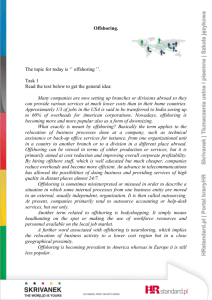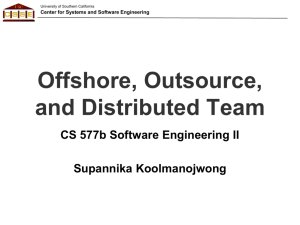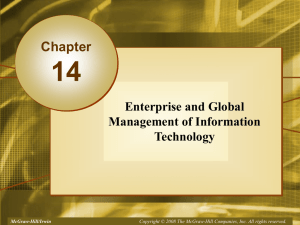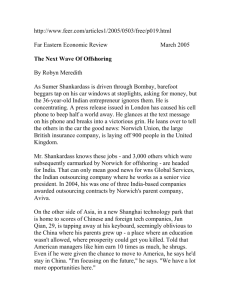Seminar 7
advertisement
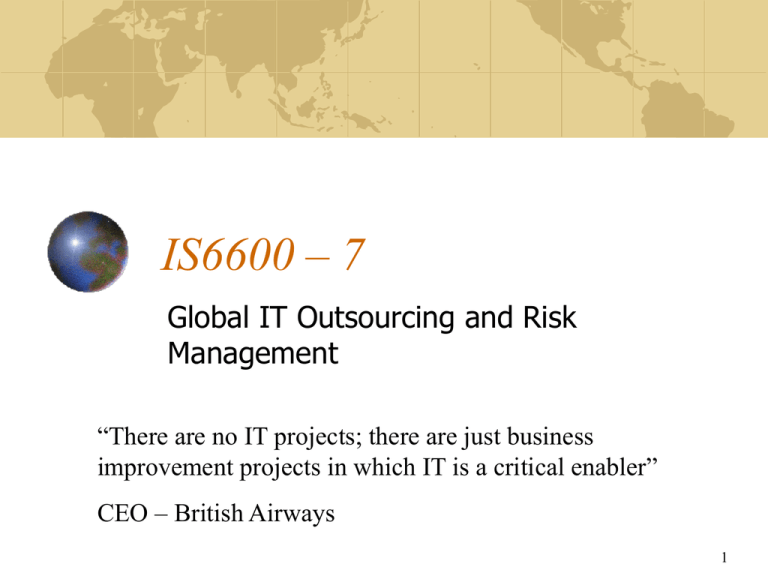
IS6600 – 7 Global IT Outsourcing and Risk Management “There are no IT projects; there are just business improvement projects in which IT is a critical enabler” CEO – British Airways 1 Learning Objectives Familiarisation with Offshoring and associated Risk Management Issues Focus on IT services and system development Plans for the offshore process (so as to mitigate risks) 2 Outsourcing This is an increasingly common practice It means that (usually) non-core-competence activities are undertaken by a third party Typical examples include IT–related services [ITO] • New software development, inc. analytics, BI, big data • Cloud-based solutions • Mobile-enabled solutions Business process services [BPO] • E.g. data entry, customer call centre 3 When Not to Outsource? [SAP] Is the function a core strategic component or differentiator to your business? Do you need complete control of this function to deliver your value add? Do you perform this function better or at a lower cost than anyone else? If you answer ‘yes’ to all 3, then outsourcing does not seem sensible. http://news.sap.com/small-business-coach-outsourcing-hold-advantages-small-business/ 4 Key Goals to Achieve? (KPMG 2015) Cost reduction – 87% Greater scalability – 82% Process standardization – 74% Access to better technology – 62% Improving analytical capabilities – 62% 5 Costs or Something Else? Outsourcing always used to be costfocused Today, the trend is towards identifying new value-adding opportunities Outsource so as to locate talent and innovation Domain expertise and technology skills 6 Outsourcing The work may be undertaken in a variety of locations Inshore – within the same country Offshore – at a more distant location Nearshore – at a nearby country or time zone Backshore – return the work to the home country Multisourcing and Microsourcing Split your project into many (small) parts and assign each one to a different provider Mobile or Nomadic software providers can be located anywhere, yet still provide services 7 Locations While India is the most popular destination, especially for low end work, South America and Eastern Europe are growing fast This is particularly the case for more complex work where qualified Indian workers are more expensive than those in EE. EU membership means that EE countries now must adhere to much higher standards of performance and work ethics Geographical proximity within Europe is one more advantage 8 Insourcing Insourcing implies that the work is done by an affiliate of the organisation, but not done centrally. Insourced work can be inshore (same country) or offshore (overseas), or nearshore (a nearby country) E.g. HSBC gets BPO work done by a subsidiary in China (Nearshore insourcing) 9 Offshoring Offshoring often implies the involvement of a cheaper and less developed country E.g. a US firm outsources software development to India E.g. an Indian firm outsources software development to Vietnam But there are many hazards as well Managerial, HR, Work Style, Political, currency and wage fluctuations, competition for employees, regulatory issues … Offshoring should be a strategic choice, not an accidental mistake Failing to plan for it – is planning to fail at it! 10 Offshoring - Transitions On July 17th 2014, Microsoft said it would lay off 18,000 employees, many of them ex-Nokia factory workers in China Much of this work will move to Vietnam, some to Brazil and Mexico. This is a form of right-shoring Moving production to the right location 11 Right Shoring Move phone production to Hanoi Some capacity retained in BJ and DG Move other operations to Brazil and start to close Komaron (Hungary) Samsung also plans to move production from China to Vietnam Why? Moving production closer to consumption. Costs. 12 Costs China is no longer a cheap destination for factory work The middle class is growing and so wages are rising Factory workers cost more So, work will move to cheaper locations South East Asia, South Asia 13 Consequences When jobs move, people lose their jobs! In early 2015, SCE laid off 400 IT workers as it outsourced work to India The same American IT workers had to train the people who would replace them! http://www.computerworld.com/article/2879083/southern-california-edison-it-workers-beyond-furious-over-h-1breplacements.html 14 The Big Four: Brazil, India, China and Russia Large number of engineering graduates and well-qualified employees Thousands of software exporting firms But around 120 countries provide some offshoring services (RO, CR, PH, VN, PL, HU, MY, AR, FJ,…) The Indian firms in particular are now global firms in their own right – with offshore operations to service clients ‘locally’. Offshore sites in AU, CN, HU, JP, UK, US, UY A significant threat to US- and Europe- based firms 15 The Provider (Vendor) Perspective In over 120 countries, firms have been set up offering BPO/ITO services www.nearshoreinfo.com Industry & Technology parks • China graduates four times as many engineers as the US • China has tens of software/technology parks, each focusing on domestic and global markets • www.zpark.com.cn • www.xasoftwarepark.com 16 Diversification or Centralisation? Diversification has long been a good practice in the financial investment industry – but in outsourcing, the same is not true. Most providers are located in a single country, and even a single location, concentrating the risks. Diversification can help to reduce the impact of risks. 17 Diversification - Example A French company offshored 2,000 high-end IT jobs Initially it planned to locate them all in Bangalore, India. Later decided to adopt a more diversified approach: 65% in India @ $20k/year/head 15% in Romania @ $25k/year/head 15% in Egypt @ $20k/year/head 5% in France @ $40k/year/head Why these countries? Romania - closer proximity to European markets. Egypt - new talent availability. Total cost slightly higher than an all-India approach, but diversification reduced risks. 18 Diversification Issues In the more popular offshore locations, the providers compete with each other for the best talent – this produces a lot of turnover, as well as higher wage costs. Few locations are better than all others on all counts – diversification brings in new skills, new languages, new values. India is obviously highly penetrated by offshore work, yet there are many other providers in South America, the Middle East and SE Asia. Time zone issues, suitability of the local skill base, proximity to key customers, government initiatives – can all play an influencing role. 19 Strategic Issues 1 Cost “In India, we can get three security engineers for the cost of one in the U.S.” But, is cheaper really strategic? Total Cost of Engagement? • China is cheaper than India for programmers, more expensive for Supervisory & Mgt staff. • There can be many hidden costs… • If you always worry about cost, you will get poor quality solutions. Quality costs! 20 Strategic Issues 2 Talent Access resources unavailable at home • But employee churn and provider reliability is a major problem • Resource quality (esp at smaller providers) • Knowledge transfer and the risk of IP loss/theft • Do you share values with the provider? • Good governance? Ethics? Efficiency? Flexibility? 21 Strategic Issues 3 Agility Respond to opportunities and get products to market faster • If you can overcome the differences of language, communication style, culture Anything strategic requires a corresponding investment of resources – and a long term vision. 22 Strategic Issues 4 Take advantage of time zone differences Send work from time zone to time zone • US to S or SE Asia to Europe • Non-stop work But coordination must be perfect Few success stories Small and simple tasks are more suitable 23 Captive Centres 1 Captive Centres Wholly owned subsidiaries that work (more cheaply) for the parent company. Captive Centres accounted for 25% of the US$150B global services market in 2014. 64% of CCs employ more than 500 professionals, but smaller firms are adopting too More than half of all CCs are in India Scale and scope of work is attractive New entrants in: PH, PL, CN, MY, CR, RO 24 Captive Centres 2 Three Captive Centre Development strategies: Hybrid, Shared and Divested. Hybrid: The Captive Centre outsources (inshore) work to a local service provider, so that some work for the parent is done internally, some externally. Shared: The Captive Centre also takes on work from other clients, making it a profit centre – and rendering it liable for acquisition by an investor. Divested: The Captive Centre may be sold if the parent is assured that it will not lose quality of service under new management. 25 Captive Centres 3 The management of a captive centre should depend on a strategic position Why was the Captive Centre set up? What is its longer term objective? A poorly managed captive centre can be a drain on finances, as they have large fixed costs There are many examples of failed CCs: Citigroup, Deutsche Bank, Unilever, Dell And successes: ANZ, WNS, Genpact 26 For Example – ANZ Bank 1 Developed an integrated Captive Centre offshore in Bangalore for ITO and BPO operations. The bank set out to create ANZ in Bangalore with fully integrated ANZ culture. Work includes back-office processing for • • • • • credit cards, mortgages, wealth management products, a/c payable HR. 27 ANZ Bank 2 IT graduates in Bangalore were paid at A$8k/annum, compared with A$4550k/annum in Australia. Although India is getting more expensive, labour costs are still sufficiently low to mean that India is an attractive destination for offshored work. By focusing on culture, ANZ Bangalore is also producing individuals who can move out into other parts of India and further instill the culture there. 28 Offshoring IT Services “If you want the loan application processed today, click ‘1’ and it will be done in Fiji today. Otherwise press ‘2’, it will be done in this country by next month’. What % clicked ‘1’? There is increasing offshoring of IT services Application processing, telemarketing, helpdesking, airline reservations, data entry, etc. 29 Offshoring IT Services All these services are highly dependent on both IT and language The relevant data is mobile – it can be sent through the Internet easily HSBC employs thousands of staff in China, India and Malaysia. English speaking countries (populations) have a distinct advantage But can you understand Indian English? 30 Languages, Skills and Gov’t Support Dubai and Singapore – IT security skills PH, LK, IN, – English language call centres PL – Banking & Financial Services MY – Asian Language Support MA – French language call centres UY, CL, VE, CO - Spanish language call centres for Spain and Hispanic USA, e.g. help-desking, patient scheduling, data entry, helped by synchronous time zones. 31 Its not just Salaries Salaries are a major cost, but also consider: Housing Medical insurance Local transportation 13th/14th/15th month bonus, etc. And lots of hidden costs, such as… 32 Hidden Costs…? Transaction costs Infrastructure costs Knowledge transfer costs Currency movements and fluctuations Dispute resolution Travel costs – in the early stages Unpredictable risks – wars, financial collapse, terrorism, regulatory changes (e.g. nationalisation, tax breaks), IP theft, corruption, proprietary knowledge, etc. 33 Is Offshoring Too Dangerous? Offshoring can be exciting or scary Depends on your appetite for adventure, for the exotic, for risks Many lessons have already been learned, and can be read, so companies considering offshoring have no excuse not to know in advance what they are getting into. But are the risks over stated? Is it really that dangerous? What should be done? 34 Three Steps to Offshoring Laying the foundations Do we have a plan, a strategy? Who is involved? Are we ready? [a year? 18 months?] Identifying the providers Which country? Which providers? Selection criteria? RFI and RFP. [6 months] Assessing & Selecting the Provider Visit the offshore location. Meet the people. Observe their work. Sign the contract. [at least a month] 35 Laying the Foundations 1 Assessing if we are ready How good is our project management? Can we manage an offshore project? Can our people work with them? Are changes in work norms acceptable? What is our appetite for risk? The hardest step is re-engineering internal processes – so as to ensure that they are ready. 36 Laying the Foundations 2 The launch team Offshoring is complex – it needs a powerful team Build a strategic vision, commitment and push for implementation Agile and able to make quick decisions Expertise in offshoring Learn from others’ experiences (including consultants) 37 Laying the Foundations 3 Strategy & Plan Precisely why are we doing this? How are we going to achieve this goal? What are the risks? Operational issues • HR costs, skill sets, current & future operations, exactly what are we offshoring, Develop a business case for offshoring • With performance indicators to measure later success – Costs, satisfaction rates, productivity rates, delivery times, benchmarking against competitors, Planning for resistance to change • How to keep key people, retrain some, let others go… 38 Identifying the Providers In India, there are thousands of providers! Many have offshore agents Globally, there are tens of countries that do offshore work Which one do you want? General skills or specific? Language? Risks? IP protection? Security? Culture? Time? What is your strategic concern? Cost, quality, efficiency? 39 Selecting a Country While selection of the provider is often done carefully, selection of the country is the subject of much less care. It may relate to personal factors or connections. Who is going to have to go and work there, to supervise and control? Can they cope? • So many expats don’t like their assignment… • Spousal/family issues. Is makes no sense to select a country that no one wants to visit or live in. 40 Provider Selection Criteria General Criteria Company size & stability HR policies Quality management Technical expertise Business domain knowledge Track record Methodologies used Costs Quality initiatives – ISO, CMM, 6 Sigma, etc. Extra care criteria Infrastructure SW production environment Interntional experience Language skills Employee turnover Org culture – flexibility, responsiveness, soft skills Global presence Disaster recovery & backup 24-hour support Weight the criteria; matrix the providers 41 Send an RFI, using the criteria Who we are What we are looking for Questions about the provider History, customers, management, geo-locations, turnover, infrastructure, security Questions on services offered Domain expertise, platforms, skills, subcontractors Questions on strategy Vision, market share, alliances 42 Send an RFP to the most promising firms What we expect in the proposal How are you going to undertake a specific project Need to provide sufficient project details Need to do a good requirements analysis Try to stimulate the provider’s creativity by asking more specific/difficult questions Ask for references of work they have done. 43 Assessing & Selecting the Provider Evaluate the RFPs Identify false promises, too good to be true offers Learn that “yes” means ‘yes’, ‘no’ and ‘maybe’. • Often all simultaneously Check the references • Ask what worked, and what didn’t. • Technology always has problems. Soft issues – culture, values, trust, wavelength. Don’t only look at cost. 44 The Offshore Visit Important for large/complex projects, longterm cooperation and situations where there is a high degree of dependence on the provider (i.e. it is hard to switch) Launch team members should be involved, but also other members of senior management and those who are not yet convinced about offshoring. 45 Offshore Things to Do Don’t just visit the HQ, but also the work site, national software association, … Talk to other ‘foreigners’ who are there Plan the site visit carefully – not on the plane Don’t visit too many and don’t only listen to sales pitches – they are all the same. Do speak to project managers and programmers – how good are their soft skills? Walk around – literally 46 Recommendations & Contract Negotiations To offshore or not. Project objective, functionality scope, Comparison of providers Financial justifications to top mgt. Legal/contract issues: price, IP & confidentiality, penalties & incentives 47 Contract Specificity It would seem sensible to have specific contracts More quality and satisfaction?? Consultants report that a less than complete contract means more room for creativity and flexibility The vendor can then work within a framework and be creative – which is more satisfying for vendor staff They are not just being told what to do An onsite supervisor can help It requires the client and vendor to have similar cultural values – tolerance for uncertainty A client-vendor matching process is needed 48 Insourcing and Outsourcing You need to do the requirements analysis Don’t trust others to know your business better than you do Outsource the software development Software testing must be done by the users, not the developers Developers tend not to do such a good job here And if the software is not carefully tested, the chance of rejection is higher. 49 Summary Don’t underestimate the importance of careful planning, or of allowing enough time to lay the foundations carefully. The project launch team should be small, agile, open-minded and pro-offshoring A low-risk pilot project will help a company find out if it is ready for offshoring Contracts are important, but developing a relationship with the provider is probably more critical. The two parties need to align their business interests for the duration of the project. 50 Future Directions/Trends Best-shoring and Near-shoring The most appropriate location to maintain control & proximity to market Integration of domestic players even as smaller players emerge in smaller markets Diversification of risks across multiple suppliers Multisourcing Never-ending search for new sources of skills It is not just India. EE and SA will grow Outsource storage and apps to the cloud Out with the RFP (too slow and expensive), in with the enterprise marketplace 51 Concluding Remarks India is far ahead and – Brazil, Russia and China have a long way to catch up Integration of smaller players is essential Smaller players/countries will continue to provide value Planning is essential, as there are both experts and cowboys out there! Fail to plan = plan to fail 52
